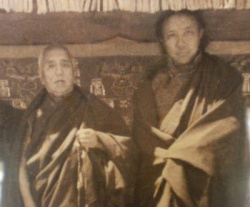Difference between revisions of "Rinpoche"
| Line 1: | Line 1: | ||
| − | [[File:Dilgo khyentse20.jpg|thumb|250px|]] | + | [[File:Dilgo khyentse20.jpg|thumb|250px|[[Dilgo Khyentse Rinpoche]] on left]] |
Revision as of 12:37, 3 August 2022

Rinpoche or Rinboqê (Tibetan: རིན་པོ་ཆེ་, Wylie: rin-po-che, ZYPY: Rinboqê) is an honorific used in Tibetan Buddhism. It literally means "precious one," and is used to address or describe Tibetan lamas and other high-ranking or respected teachers. This honor is generally bestowed on reincarnated lamas, or Tulkus, by default. In other cases it is earned over time, and often bestowed spontaneously by the teacher's students.
Rinpoche is the is an honorific term used in the Tibetan language also spelled Rimboche and Rinboqê.
The word is a combination of (Rin) which is called value and (Po) means nominative suffix and Chen means big.
Rinpoche, also spelled Rimboche and Rinboku, is an honorific term used in the Tibetan language. It literally means "precious one", and may refer to a person, place, or thing—like the words "gem" or "jewel". The word consists of rin (value), po (nominalizing suffix) and chen (big). The word is used in the context of Tibetan Buddhism as a way of showing respect when addressing those recognized as reincarnated, older, respected, notable, learned and/or an accomplished Lamas .
Honorific applied to reincarnate lamas and other highly respected persons. "Rinpoche" means "precious" and refers to someone who in their last life attained such a high degree of mastery that they did not have to take any more rebirths. However, out of their compassion for others, they took another birth at will - or rather took a human form - in order to teach others. Hence, they are "precious" because they returned to show us how to do it ourselves.
Kang Rinpoche is the Tibetan name of Mount Kailash, sacred to Bön, Hinduism and Jainism as well as Buddhism. Kang Ri is a Tibetan expression for "snow peak" analogous to alp or himal.
Guru Rinpoche refers to Padmasambhava, the "Second Buddha", who brought Tantric Buddhism to Tibet.
Je Rinpoche refers to Je Tsongkhapa, the founder of the Gelug School.
In film
The documentary films The Reincarnation of Khensur Rinpoche (1992)[2] and Unmistaken Child (2008)[3] document the lengthy procedure of searching for and finding the reincarnation, or tulku, of a Tibetan lama.
The documentary films Tulku (2009)[4] and My Reincarnation (2010)[5] document the existence and struggles of Tibetan Buddhist masters who have reincarnated in the West.